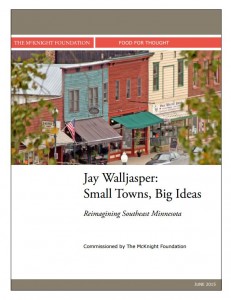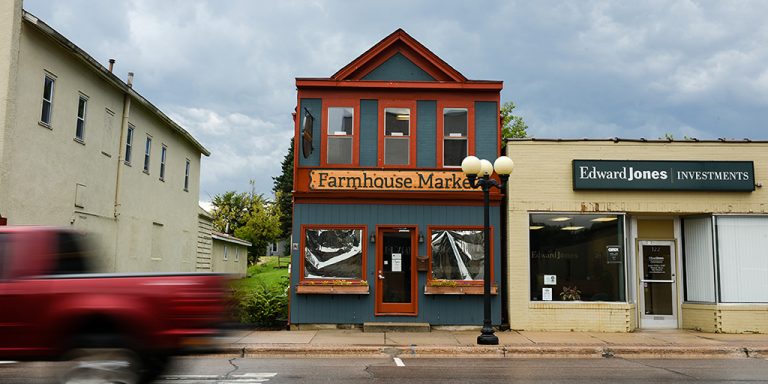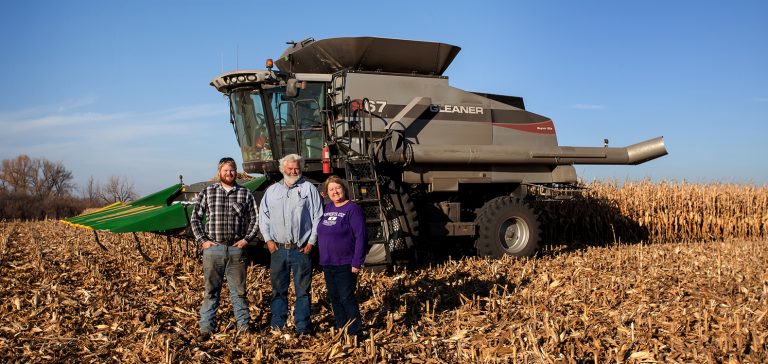Below is Vice President of Program Neal Cuthbert’s foreword from the McKnight-commissioned Small Towns, Big Ideas: Reimagining Southeast Minnesota, an essay by Jay Walljasper that explores innovative examples of economic resilience in Southeast Minnesota that could serve as models for the entire Midwest.
 Jay Walljasper’s Small Towns, Big Ideas: Reimagining Southeast Minnesota was commissioned by The McKnight Foundation as part of our “Food for Thought” series — a collection of independent essays to help inform our understanding of the fields in which we operate and our related program strategies. This is the first in a four-part series examining the opportunities and challenges in Minnesota’s countryside.
Jay Walljasper’s Small Towns, Big Ideas: Reimagining Southeast Minnesota was commissioned by The McKnight Foundation as part of our “Food for Thought” series — a collection of independent essays to help inform our understanding of the fields in which we operate and our related program strategies. This is the first in a four-part series examining the opportunities and challenges in Minnesota’s countryside.
Since 1986, The McKnight Foundation has invested over $270 million in the Minnesota Initiative Foundations — six independent regional philanthropic organizations with priorities defined by the people in its own region. They offer grants and loans to support prosperous and diversified local economies, protect natural resources, cultivate strong leadership, and offer innovative social services.
As communities in Greater Minnesota strive to develop 21st century economies, they face steep hurdles. High-wage jobs can be scarce. Broadband connections are erratic. Firms have trouble recruiting young talent and aspiring entrepreneurs struggle to attract investment capital. Largescale agriculture and extractive industries deplete natural resources and leave towns vulnerable to global market swings. And then there’s the deep sense, real or imagined, that non-metro areas are underappreciated and shut out of important political conversations happening in the state capitol.
 It may seem like a bleak picture, but there are good reasons to be optimistic. Traveling to southeastern Minnesota, Jay Walljasper finds communities that are overcoming these adversities. His report highlights some innovative examples of economic resilience that could serve as models for the entire Midwest. It begins with Rochester and the city’s ambitious plans to become a Destination Medical Center, which may add as many as 40,000 jobs and double the population. But it doesn’t end there. Municipalities from Lanesboro to Winona to Red Wing are re-inventing what it means to be a small town in the heartland.
It may seem like a bleak picture, but there are good reasons to be optimistic. Traveling to southeastern Minnesota, Jay Walljasper finds communities that are overcoming these adversities. His report highlights some innovative examples of economic resilience that could serve as models for the entire Midwest. It begins with Rochester and the city’s ambitious plans to become a Destination Medical Center, which may add as many as 40,000 jobs and double the population. But it doesn’t end there. Municipalities from Lanesboro to Winona to Red Wing are re-inventing what it means to be a small town in the heartland.
Many smaller cities and towns in this region have embraced bold imagination as a way to find their place in the future. Their civic leaders are looking beyond the traditional mainstays of rural Minnesota and building economic engines based on specialized fields as diverse as tele-medicine and ecotourism. Their streets have a vibrant mix of artist lofts, co-op markets, and start-up incubation labs. And their native residents welcome newcomers. As a result, their main streets are bustling with new businesses and their public squares are buzzing with rich cultural offerings, all while retaining their historic charm and sense of place.
There is no one-size-fits-all when it comes to how a community can thrive. And with growth and change inevitably come fresh challenges, which is precisely why it’s worthwhile to occasionally pause and reflect on these issues. We invite you to come with us to southeastern Minnesota and learn how our neighbors are creatively working toward a vision where prosperity can be shared throughout the state.


